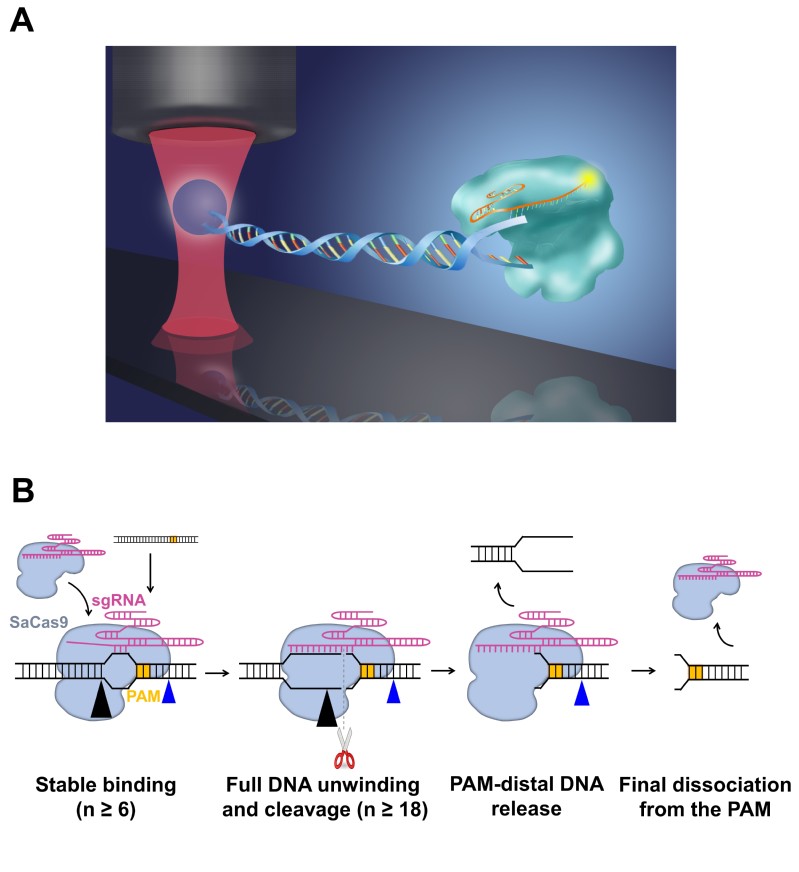A research team led by Professor Sun Bo from SLST has systemically investigated the molecular mechanism governing DNA binding, unwinding and cleavage by SaCas9. They provided a detailed dynamic understanding of SaCas9 in DNA target association and dissociation. In addition, two stable interactions between SaCas9 and DNA governing their interplay have been identified. On August 13, this study was published in the journal EMBO Reports entitled “Dynamics of Staphylococcus aureus Cas9 in DNA target Association and Dissociation”.
Clustered regularly interspaced short palindromic repeats (CRISPR)–associated (Cas) systems equip bacteria and archaea with adaptive immunity against foreign invasive genetic elements. In type II CRISPR-Cas systems, a single Cas9 protein in complex with a dual-guide RNA comprising CRISPR RNA (crRNA) and trans-activating RNA (tracrRNA) is sufficient to identify and cleave foreign DNA. This ribonucleoprotein complex functions as a programmable endonuclease that targets complementary DNA sequences for site-specific double-stranded DNA (dsDNA) cleavage. The simplicity, flexibility, and high efficiency of these systems have given rise to their wide in vivo applications as versatile genome tools in various organisms. However, the in vivo delivery of the Cas9 enzyme with engineered single-guide RNA (sgRNA, which is a synthetic fusion of crRNA and tracrRNA) is often restricted by the cargo sizes of viral vectors. Compared with the commonly used Streptococcus pyogenes Cas9 (SpCas9) which has 1,368 amino acids, Staphylococcus aureus Cas9 (SaCas9) is a 1,053 amino acid enzyme. Advances in understanding of the molecular mechanism of SaCas9 underlying its RNA-guided DNA recognition and cleavage would not only facilitate its better usage as a genome tool but also aid in the development of its derivatives and the expansion of its applications.
Using a series of single-molecule approaches, Professor Sun and his colleagues studied the mechanism of SaCas9 underlying its interplay with DNA (Figure 1A). They found that SaCas9 activity is mediated by two PAM-flanking interactions with the DNA target. Moreover, the DNA binding and cleavage of SaCas9 require complementarities of 6- and 18-bp of PAM-proximal DNA with guide RNA, respectively. Interestingly, SaCas9 quickly releases the PAM-distal DNA after cleavage and remains associated with the PAM for hours. This partial DNA release immediately abolishes its strong interaction with the protospacer DNA and consequently promotes its subsequent dissociation from the PAM. Overall, these data provide a dynamic understanding of SaCas9 (Figure 1B) and instruct its effective applications.
This work was supported by the National Key R&D Program of China, Natural Science Foundation of Shanghai, and ShanghaiTech University Startup funding.
Article link:
https://www.embopress.org/doi/10.15252/embr.202050184

Figure 1. (A) A combination of optical tweezer and confocal microscopy to detect the dissociation of SaCas9 after DNA cleavage. (B) Proposed model for SaCas9.


